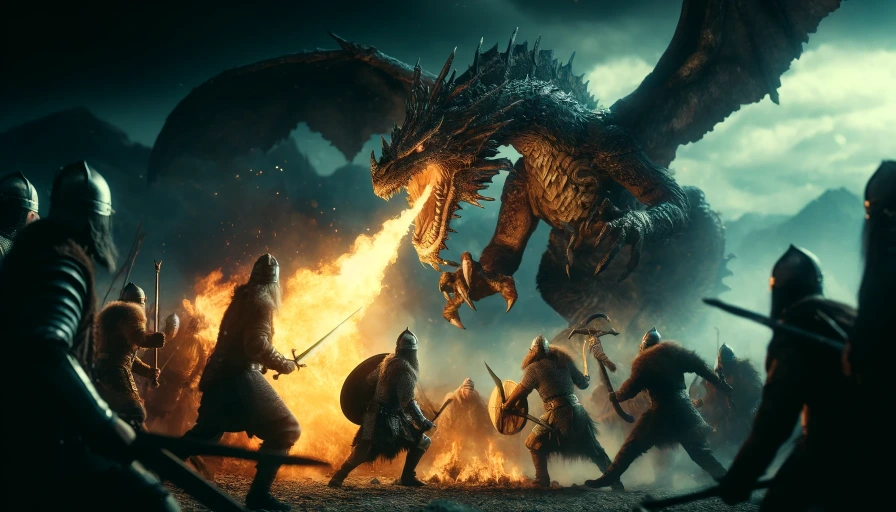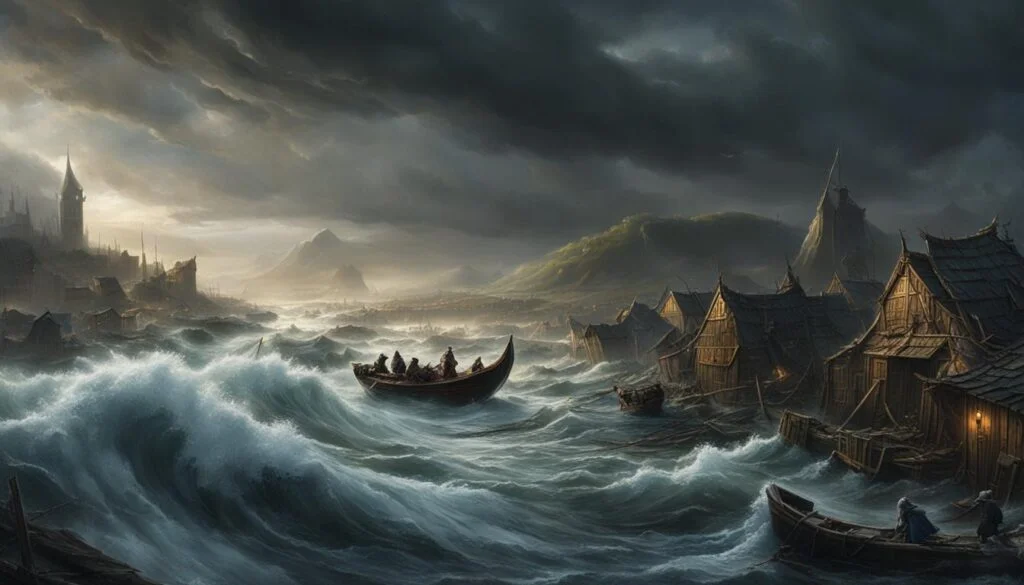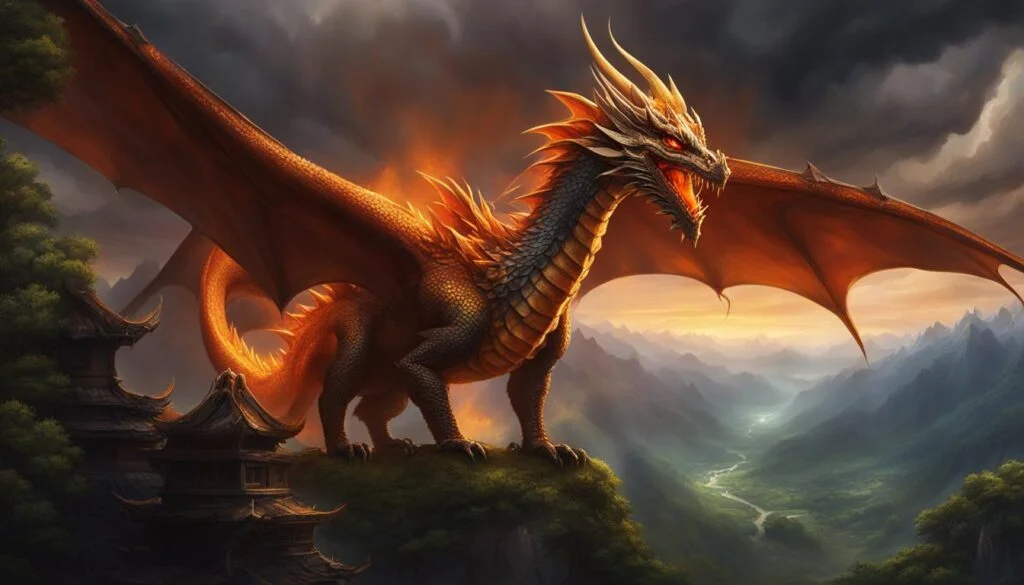In Norse mythology, Nidhogg (or Níðhöggr) was a fearsome dragon that gnawed at the roots of Yggdrasil, the world tree, symbolizing the ever-present force of destruction and decay in the cosmos. This malevolent creature resided in Niflheim, the realm of the dead, and played a crucial role in the Norse cosmological cycle of destruction and rebirth. Nidhogg’s actions were believed to help maintain the balance of the world by contributing to the cycle of destruction that ultimately leads to renewal.
Nidhogg also appears in the Völuspá poem, marking the start of Ragnarök. This isn’t just a story, but a deep-rooted event.
As Nidhogg escapes Yggdrasil’s roots, it fights in the final battle and then survives. This shows its role in both destruction and rebirth.
Key Takeaways:
- The formidable entity of Nidhogg in Norse mythology serves as a constant menacing presence beneath Yggdrasil, the world tree.
- Steeped in ominous symbolization, Nidhogg’s actions embody the ceaseless struggle between order and chaos.
- Ragnarök, the end of the world as foreseen by the Nordic seers, is closely linked with Nidhogg’s foretold rise from the underworld.
- Nidhogg’s influence persists in Náströnd, where it metes out a symbolic form of eternal punishment for the wicked.
- Modern interpretations of Nidhogg resonate with themes of societal decay, dishonor, and the enduring cycle of destruction and renewal.
- Despite its contested contributions in ancient texts, Nidhogg continues to foster debate and fascinate scholars of Norse mythology.
Unveiling the Serpent: Who is Nidhogg?
In the rich world of Norse Mythology, the dragon Nidhogg is a vital symbol. It shows us the concept of cosmic entropy.
Who is Nidhogg in Norse Mythology takes us deep into where legends and stories mix.
Nidhogg eats at Yggdrasil’s roots, showing that nothing, not even cosmic structures, avoids the time and evil’s touch.
Understanding Nidhogg’s Moniker and Origins
Looking into Nidhogg’s Origins, we find its name holds deep meaning. In a world valuing honor, Nidhogg stood for all things opposite.
Living in Náströnd, it reminded everyone of the consequences of grave sins.
Deciphering the Meaning and Implications of ‘Níðhöggr’
The name ‘Níðhöggr’ has deep and dark layers. Knowing the Meaning of Níðhöggr shows a being tied to Ragnarok’s catastrophic events.
By gnawing, Nidhogg threatens the Universe, showing the Norse cycle of life: creation to rebirth.
Nidhogg’s story isn’t stuck in ancient texts. It lives on in art, games like Age of Mythology and Eve Online, and the World of Dragons series.
Collectors and fans see these myths celebrated in ways that keep Nidhogg’s legend alive today.
Yggdrasil and Its Eternal Tormentor
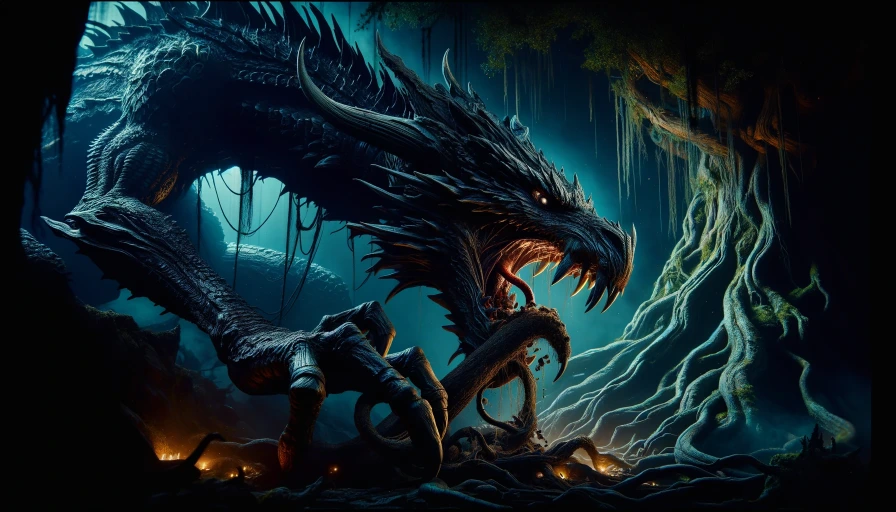
In Norse myths, the story of Yggdrasil and Nidhogg shows a timeless battle. It’s about how creation and destruction always fight each other.
This tale also reveals how Nidhogg’s evil actions help keep balance in the world tree’s life. We see how destiny ties Yggdrasil and Nidhogg in a sad harmony.
The World Tree and Nidhogg’s Devastating Actions
Yggdrasil holds up the Nine Worlds. It’s like the universe’s backbone. But beneath it, Nidhogg brings decay.
This giant snake eats away at Yggdrasil, showing how everything goes through cycles of dying and being reborn.
Nidhogg’s actions at Náströnd remind us of the connection between death and renewal.
When Ragnarök comes, Nidhogg will do more than just destroy. A prophecy says it will rise with the dead as it flies from Helheim.
Nidhogg then becomes not just a destroyer but also a sign of the world’s end. It brings chaos to gods and giants alike.
Nidhogg’s Place Among Yggdrasil’s Diverse Inhabitants
Yggdrasil is full of life, each being part of a larger purpose. But Nidhogg brings conflict into this balance. It represents darkness against Yggdrasil’s light.
Its presence among other creatures reminds us how fragile peace can be.
Nidhogg is huge and scary, with sharp teeth and a deadly stare. Its name means “striker,” fitting for something that constantly attacks Yggdrasil.
Nidhogg sitting in Náströnd shows it’s not just any monster. It’s a powerful judge over the dishonored dead.
Nidhogg also deals with other mythical beings like Ratatoskr, the tricky squirrel. This shows how everything in Yggdrasil is connected.
The tale of Nidhogg and the World Tree mirrors the cycle of life and death. Nidhogg’s continuous attacks make sure that this cycle keeps going, playing a crucial role in the world’s endless rhythm.
The Malicious Intent: What Does Nidhogg Do in Norse Mythology
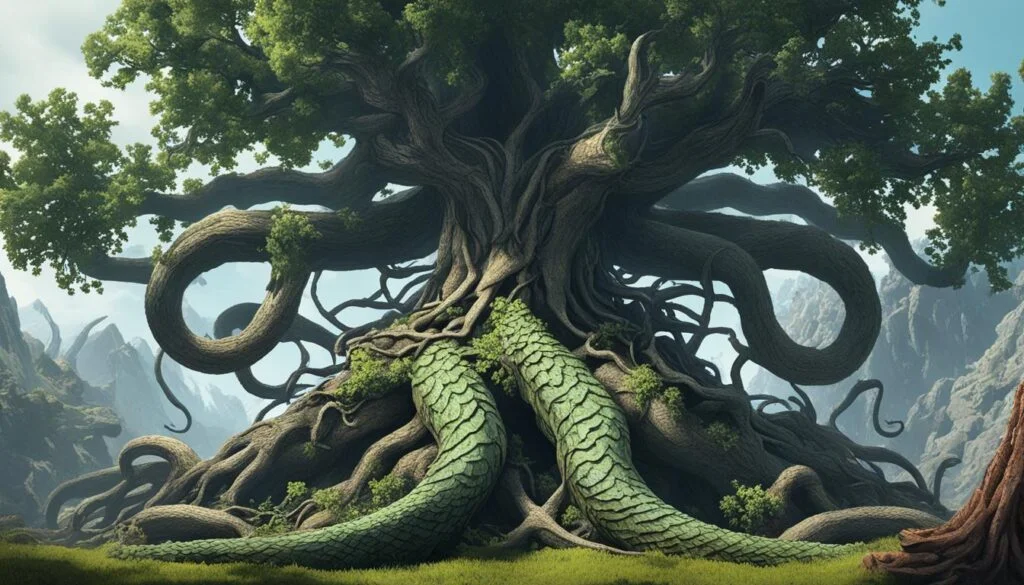
The Role of Nidhogg in Norse Mythology is profound, representing a dark force that threatens existence itself.
Norse mythology is vast, filled with many beings and worlds. Nidhogg, meaning “Malice Striker,” serves as a powerful symbol of destruction.
This creature lives in Hvergelmir, one of Yggdrasil’s root wells. Here, Nidhogg doesn’t just exist; it attacks all realms’ stability every day.
Nidhogg lived near the cold, desolate Niflheim, posing a constant threat to life and order.
He feasted on the souls of wrongdoers in Nastrond, a place of debate among scholars.
The creature, a great eagle, and a squirrel named Ratatoskr were involved in a bitter feud.
They exchanged harmful messages, highlighting a deep cosmic conflict.
- The imagery of Nidhogg breaking free from Yggdrasil’s roots, corpses entangled in his feathers as he soars, vividly depicts chaos unleashed, as mentioned in the Poetic Edda.
. - Modern interpretations tie Nidhogg’s relentless destruction to societal decay, positioning him as either a punitive demon, a harbinger of the end, or a mere symbol of warning.
. - Though not a key player in the Ragnarok prophesy, his actions inadvertently contribute to its onset, illustrating how even indirect influence can culminate in cataclysmic outcomes.
Nidhogg played a crucial role in Norse mythology. His constant attacks on Yggdrasil’s roots hinted at an impending doom.
Yet, his story is vital to understanding Norse belief. Even after Ragnarok, Nidhogg’s influence remains, showcasing his part in changing the cosmos and sowing chaos.
We learn a lot from Norse myths, like the importance of Ratatoskr’s messages, Yggdrasil’s endurance, and Nidhogg’s wide-reaching impact.
These stories show how everything is connected and must stay in balance.
Nidhogg’s story warns us about the darkness lurking, ready to disrupt our world. It reminds us that one entity’s actions can have a far-reaching impact.
Chaos, embodied by Nidhogg, is a mighty force not to be underestimated.
Symbols of Chaos: Nidhogg as a Harbinger of Ragnarok
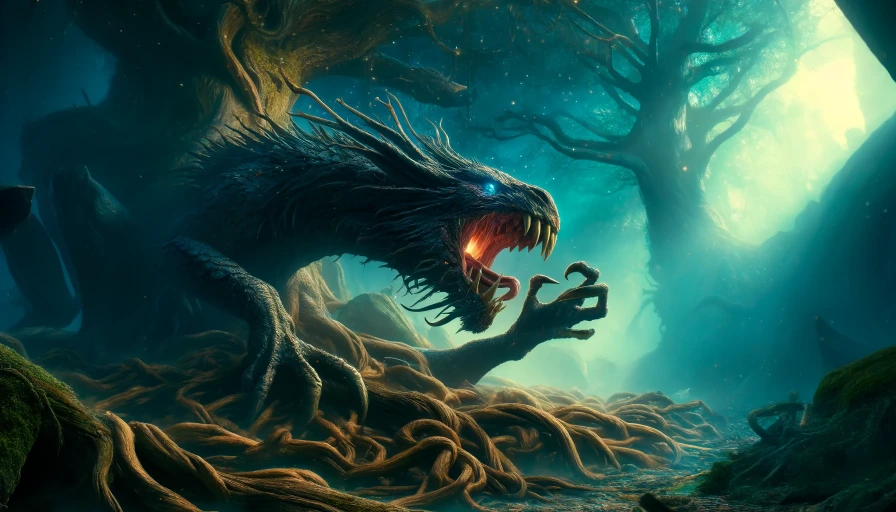
In Norse mythology, powerful symbols represent the cosmos’s dual nature. The creature Nidhogg is one such symbol, warning of Ragnarok.
This is the end of the gods, as told by ancient seers. Nidhogg’s role in Ragnarok is more than just fascination.
It shows how it acts as an agent of inevitable change, reflecting on the symbolism of Nidhogg in Norse Mythology.
Nidhogg exists beneath the Yggdrasil tree, close to Niflheim’s cold. It symbolizes decay attacking existence’s roots.
While Nidhogg is not a main player in Ragnarok, its presence highlights the constant threat of chaos.
People have compared Nidhogg to the darkness in society, undermining honor and morality, similar to its endless attack on the World Tree.
The struggle between order and chaos is clear in Norse stories. One depicts Nidhogg and an eagle atop Yggdrasil, locked in endless conflict.
A squirrel, Ratatoskr, acts as their messenger. This battle symbolizes the endless cycle of eras, hinting at both an end and a new start.
- Nidhogg’s home in Hvergelmir ties it to life and death within Yggdrasil.
- Nastrond brings mystery to Nidhogg’s story, adding depth.
- Its battle with the eagle shows the interconnectedness in Norse myths, from high to low realms.
- Nidhogg’s place near Yggdrasil’s roots points to a link between creation and destruction.
- Nidhogg represents dishonor, destruction, and decay, crucial to Norse mythology’s moral themes.
Along with Jörmungandr and Fenrir, Nidhogg signals the end times in Norse legends.
Their stories balance on the edge, captivating those seeking ancient wisdom. Through eddas and sagas, these old stories reach us, full of symbolism and epic tales.
They are a key part of Nordic heritage, still enchanting us today.
Looking into Nidhogg and Ragnarok is not just about studying old stories. It helps us see the ongoing cycle of creation and destruction in human culture.
Reflecting on the gods’ fate and the meaning of Odin’s ravens reveals deep truths about reality.
Exploring creatures like Nidhogg offers insights into Norse society’s values and fears, uncovering the meanings they offer us even now.
Dwelling in the Depths: Nidhogg’s Abode in Norse Cosmology
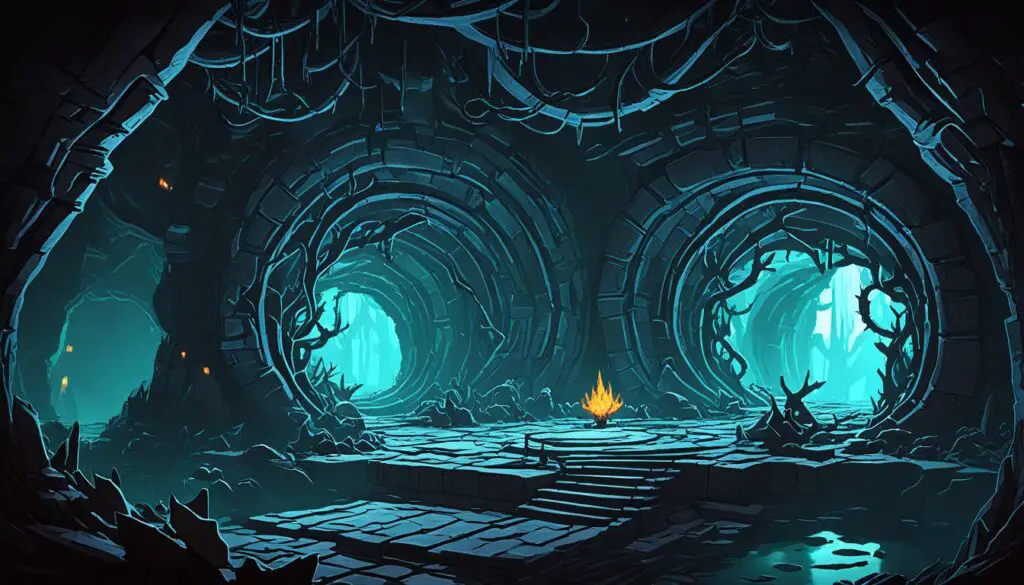
In the dark realms of Norse myths is Nidhogg’s Abode in Norse Cosmology. This terrifying dragon plays a key role in Viking stories, symbolizing both life’s cycle and chaos.
It’s linked to the cosmic tree, Yggdrasil, acting as a dark protector whose deeds affect the nine worlds.
Niflheim and Nidhogg share a deep bond. Niflheim’s icy lands of the dead are a perfect place for Nidhogg’s scary role.
Here, Nidhogg watches over where the wicked are punished forever on Nastrond’s barren shores.
Exploring Nidhogg’s Relationship with Niflheim
Niflheim is cold and misty, home to those dishonored in death. It’s also where chaos and order hang in the balance.
Nidhogg eats at Yggdrasil’s roots, wanting to start Ragnarok and change the cosmos.
Nidhogg’s Inhabitance Beneath the World Tree
Yggdrasil connects everything in Norse mythology. It faces constant threats from Nidhogg below.
The tree stands on three roots, with Nidhogg attacking them to bring chaos. Gnawing at the roots of Yggdrasil, he aims to destroy the world’s balance.
Nidhogg in the Pages of the Poetic Edda
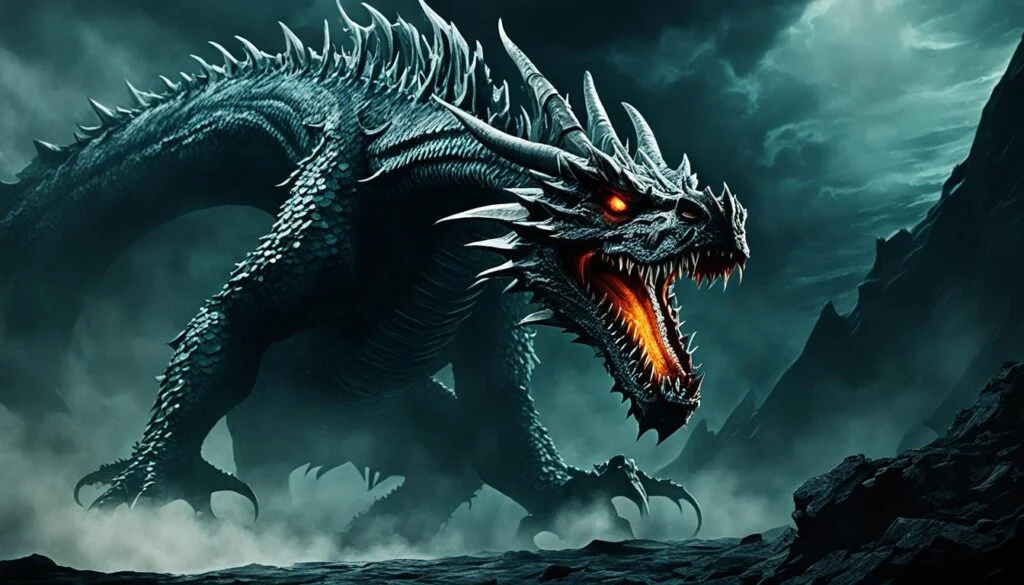
Within the ancient stanzas of the Poetic Edda, we find Nidhogg in Völuspá and Grímnismál.
Its ominous presence shows Nidhogg’s important role in Norse Poetry. Our exploration of these texts teaches us about this feared and respected monstrous entity in Norse myths.
Nidhogg’s Mention in Völuspá and Grímnismál
Grímnismál gives us a clear picture of Nidhogg gnawing at Yggdrasil’s roots. This strong image is like in Völuspá, where Nidhogg drinks the blood of the dead.
It shows death and life’s cycle in Norse mythology.
The Edda ends with a dark vision. It describes the dragon flying with the dead, signaling a world filled with conflict and collapse.
Interpreting Nidhogg’s Role in Ancient Poetic Sources
The Eddas help us see Nidhogg’s many roles. As the world-eater, it threatens cosmic balance and symbolizes disgrace in Viking culture.
By studying these texts, we see Nidhogg as more than a creature.
It represents destructive forces in our minds and nature, hinting at Ragnarok’s coming chaos. These stories don’t just share myths.
They make us think about revival, showing how the dragon’s story is part of Norse legends.
The Bedeviling Beast: Nidhogg’s Kinship with Norse Giants
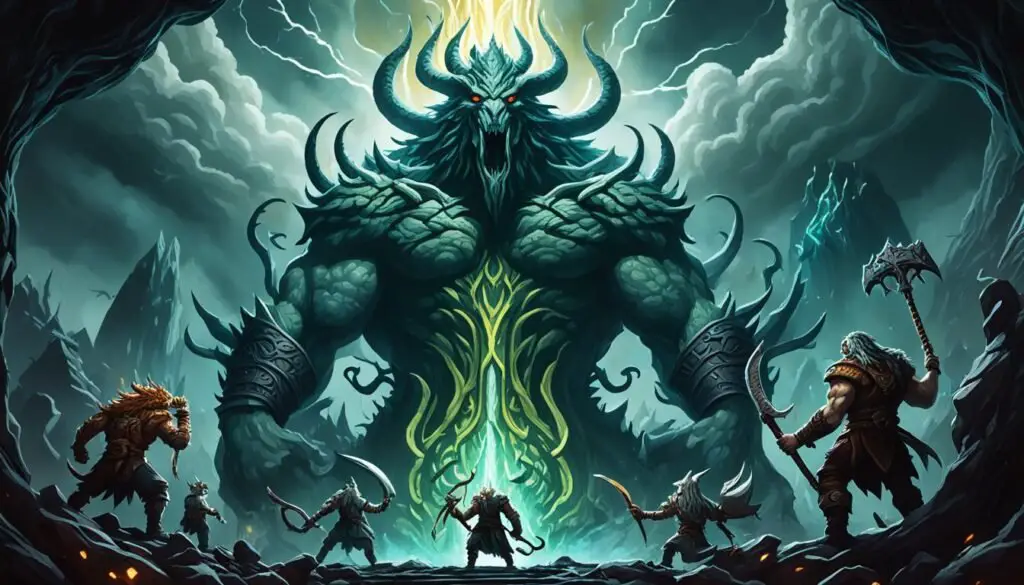
In Norse myths, Nidhogg represents evil, closely tied to the cosmos and Norse Giants.
This dragon chews on Yggdrasil’s roots, linking its chaos to the giants’ destruction.
Nidhogg’s Connection to Giants shows a shared love for ruin, hinting at Ragnarok’s approach.
Nidhogg and Giants are paired in the Prose Edda for a reason. They represent chaos in a world where everything is connected.
Nidhogg’s deeds and the giants’ actions show a deep crack in the world’s fabric, threatening all of creation.
Exploring Giants in Norse Mythology sheds light on Nidhogg’s infamy. They both await Ragnarok, when chaos will defeat order.
More than villains, they play key roles in teaching about life’s cycles of creation and destruction.
Nidhogg’s fate intertwines with Asgard’s defenders and their foes, the giants. As Odin sought wisdom, these stories reveal the deep conflicts of life.
They connect ancient lessons with our enduring human struggles.
- The serpent-like Nidhogg lies beneath Yggdrasil, signaling a perpetual threat.
- Giants in the Norse lore stand akin to Nidhogg in their cataclysmic potential.
- The roots of figurative and literal destruction meet at the tale of Nidhogg and the giants.
The link between Nidhogg and the Norse Giants reminds us that chaos and order are intertwined. Just as day follows night, new beginnings come from the old’s end.
The Savage Serpent’s Significance: Nidhogg and the Morality of Men
In Norse legends, the serpent Nidhogg plays a big role. It shows us the dangers of envy and moral decay.
Nidhogg’s Significance in Norse Mythology goes beyond harming Yggdrasil. It’s a symbol of how envy can hurt societies.
Nidhogg’s Portrayal as the Moral Degradation of Humanity
Nidhogg represents envy strongly. This feeling attacks unity in families and societies. It reminds us of Nidhogg and Morality.
The story “King Lear” shows the pains caused by jealousy.
The Allegorical Interpretation of Nidhogg’s Actions
In stories like “Metamorphoses” and Aglauros’s tale, envy’s destruction is clear. The theme of fairness comes before we see envy’s harms.
Freud and Melanie Klein studied envy’s effect on us. The Symbolism of Nidhogg shows it’s both a real threat and an inner challenge.
- Envy appears in politics as “the politics of envy”, showing how some use it when losing power.
- “Soliloquy of the Spanish Cloister” shows envy leading to self-destruction.
- Myths have figures like wolves, snakes, and toads that symbolize envy’s damage, like Nidhogg’s destruction.
Norse mythology offers us deep lessons. Nidhogg reflects our internal moral struggles. It pushes us to think about our own moral values.
Cultural Impact: Nidhogg’s Presence in Modern Media
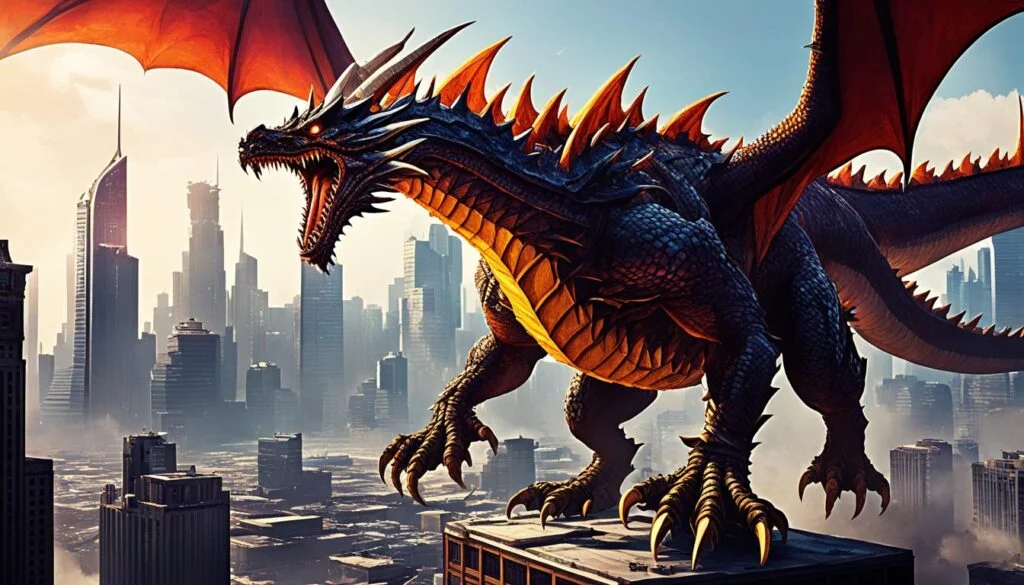
The mythical Nidhogg has moved beyond old Norse stories into today’s entertainment. It appears in many forms across different media.
A key area is Nidhogg’s Influence in Pop Culture, especially in games. This lets fans engage with Norse tales in an exciting way.
Nidhogg’s Influence on Video Games and Pop Culture
In video games, Nidhogg is a fierce enemy and a strong symbol. Games like ‘World of Warcraft’ and ‘Final Fantasy XIV’ feature Nidhogg.
Players see it as a creator of destruction, echoing its mythological role.
Modern Representations and Symbolism of Nidhogg
Beyond games, Nidhogg’s Symbolism in Popular Culture lives on in art, books, and music. It tells modern stories of chaos.
Artists like Tom Strom use Nidhogg as inspiration in various art forms. This includes tattoos and music album covers.
So, Nidhogg has smoothly moved into our culture today. It shows Nidhogg’s Influence in Pop Culture and its status as a cultural symbol.
It evokes fear, awe, or excitement. Nidhogg proves that legends and their themes are timeless, always finding new expressions through creativity.
Decoding Nidhogg: Scholarly Perspectives on the Mythical Serpent
The study of myths, especially about Nidhogg, is getting more attention. In Scholarly Perspectives on Nidhogg, experts dive deep into Norse myths.
They uncover meanings behind the serpent at Yggdrasil’s root. Scholars like Greenberg and others encourage us to see beyond the stories.
They show us how each detail reflects human history and beliefs.
We go back to when Nidhogg lived in Hvergelmir, near the cold Niflheim. On September 15, 2022, Mark Johnston updated us with fresh insights in Nidhogg in Academic Research.
Through his work, we picture Nidhogg escaping Yggdrasil’s roots, as told in the Poetic Edda. This act raises questions. Is Nidhogg purely evil, or showing the decay of society?
Views on Interpretations of Nidhogg vary greatly. Some think Christian morals might have changed the original pagan stories.
The mysterious messages between Nidhogg and the eagle, sent by Ratatoskr the squirrel, add layers. Is Nidhogg about destruction, or is he a symbol of disgrace?
- Analyze the concept of Ragnarök as a cyclical cataclysm within both mythological and geological frameworks.
- Investigate the links proposed between Norse cosmology and the geographical morphology of regions like the Caribbean Basin.
- Explore the speculative resonance of Jörmungandr’s embrace of Midgard and the hypothetical land bridge encircling the Caribbean Basin.
Studying Nidhogg in Academic Research shows us more than just old beliefs. It’s like a mirror to how we view ancient stories today.
We compare Norse myths to natural events in the Mediterranean and Caribbean. This suggests a deep link between mythology and Earth’s history.
We see nature’s poetic patterns, where land bridges are like the great Jörmungandr. The sinking of Midgard reflects the legend of Ragnarök’s destruction.
On this journey, we see Norse mythology as more than just tales. It’s a powerful way people expressed themselves.
It helps us understand our past, envision our future, and unravel the human condition.
Conclusion
As we conclude our journey, it’s clear that the story of Níðhögg survives the test of time.
This mythical creature, which started as a symbol of chaos in Norse myths, now captures modern hearts.
It enriches our culture by appearing in various artistic forms, honoring its legacy.
These reflect the dragon’s enduring appeal and celebrate Norse heritage, connecting us with an ancient story that remains powerful today.
Níðhögg means more than just a myth to us. Influential artists like Gustave Doré and writers such as J.R.R. Tolkien found inspiration in its story.
They portrayed the dragon with deep themes and rich imagery. This serpent, once seen as a menace and now also as a guardian, shows the complexity of ancient myths.
Níðhögg reminds us how old stories still matter today, touching our lives deeply.
Frequently Asked Questions
Q: What is Nidhogg the god of?
Nidhogg is not a god but a mythical dragon or serpent in Norse mythology. It is known for gnawing at the roots of Yggdrasil, the World Tree, embodying forces of chaos and destruction.
Q: Why does Nidhogg eat Yggdrasil?
Nidhogg eats the roots of Yggdrasil to symbolize the constant presence of chaos and decay in the world. This action is part of the cyclical nature of Norse cosmology, where destruction is a necessary precursor to renewal and balance.
Q: Who kills Nidhogg?
Norse mythology does not specifically state who, if anyone, kills Nidhogg. The creature is often seen as an eternal force of destruction that exists as long as Yggdrasil itself.
Q: What does Nidhogg symbolize?
Nidhogg symbolizes the destructive and chaotic aspects of the universe. It represents entropy and the inevitable decay that all things must undergo as part of the natural order of the cosmos.
Q: What did Nidhogg do?
Nidhogg’s primary action in Norse mythology is to gnaw at the roots of Yggdrasil, undermining the stability of the World Tree that holds all the realms. This act is crucial in the mythological representation of the balance between creation and destruction.
Q: What are the powers of Nidhogg?
Nidhogg possesses immense strength and the power to induce decay and corruption. It is a creature of considerable destructive capacity, influencing the underworld and the fate of the dead in some stories.
Q: Does Nidhogg protect the World Tree?
Contrary to protecting, Nidhogg actually harms the World Tree by continuously gnawing at its roots, representing a threat to the stability and health of Yggdrasil.
Q: What kind of dragon is Nidhogg?
Nidhogg is depicted as a fearsome dragon or serpent, often associated with the darker aspects of the world, such as death and decay. It is typically described as residing in Niflheim, chewing at the roots of the tree that connects the nine worlds of Norse cosmology.


